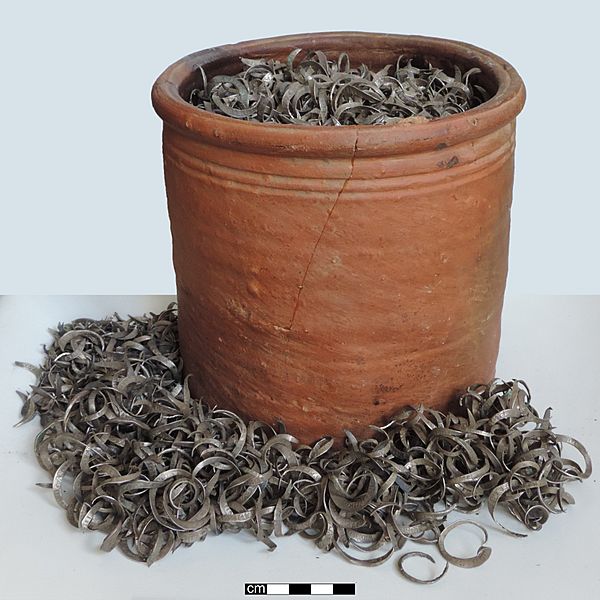Image: Post-medieval coin hoard of clippings (FindID 886014)

Description: A Post-Medieval hoard of silver coin clippings, stored in an intact ceramic jar. The hoard contains coinage of Philip and Mary (1553-1558), Elizabeth I (1558-1603), James I (1603-1625) and Charles I (1625-1649). The items were declared Treasure Trove at an inquest in 1972. The majority of clippings are of the whole circumference of the coins. That the clippings were recovered in a ceramic jar probably indicates that they were intended to be recovered and melted down. The cumulative weight of the coin clippings is 907.86g based on a report provided by John Kent, then Assistant Keeper in the Department of Coins and Medals at the British Museum, to the Derby Evening Telegraph on the 18th March 1972, though it was later described by the Portable Antiquities Scheme as weighing 'more than 1kg'. Each twist of metal would be painstakingly clipped off the edge of a silver coin. The clippings would subsequently be melted down and mixed with less valuable metals to create forged coins and other objects. Coin clipping and counterfeiting was a prevalent illegal activity in the 17th century, particularly during the period of the English Civil War, 1642-1651. Indeed, the Great Recoinage initiated by Parliament in 1696 decreed that all silver coins and clippings were to be recalled and replaced, attesting the extent to which clipping and counterfeiting comprised the currency in circulation in this period. Kent speculates that this clipping hoard could have been deposited in the ground during the Great Recoinage. A number of comparative examples are known from Derbyshire. In March 1846 another hoard of coin clippings contained within a ceramic vessel, comprising denominations of Philip and Mary, Elizabeth I, James I and Charles I was discovered a few metres from this hoard, in Beacon Medow, Alderwasley. This hoard weighed 3.6kg and its contents were melted down to create a chalice, paten, flagon, and alms dish for the local church. It is probably the case that the two hoards were collated and buried by the same counterfeiter. A similar hoard recovered from the Milnthorpe area of North East Derbyshire is recorded on the PAS database: DENO-789371. Counterfeiting has a famous historical connection to Derbyshire. 1676 Noah Bullock was apprehended for clipping and counterfeiting coins from a boat he had constructed, moored on the River Derwent near Morledge, Derby, which has colloquially become known as 'Noah's Ark'. At the time, coin forgery was punishable by execution, though Bullock was spared the death penalty and acquitted, allegedly due to a close friendship with the presiding Judge, Recorder Dregge (Armitage, J. 2014. Derby: A History. Amberley: Stroud).
Title: Post-medieval coin hoard of clippings
Credit: https://finds.org.uk/database/ajax/download/id/1000550 Catalog: https://finds.org.uk/database/images/image/id/1000550/recordtype/artefacts Artefact: https://finds.org.uk/database/artefacts/record/id/886014
Author: Derby Museums Trust, Alastair Willis, 2018-02-06 09:16:14
Permission: Attribution License
Usage Terms: Creative Commons Attribution 2.0
License: CC BY 2.0
License Link: https://creativecommons.org/licenses/by/2.0
Attribution Required?: Yes
Image usage
The following page links to this image:

